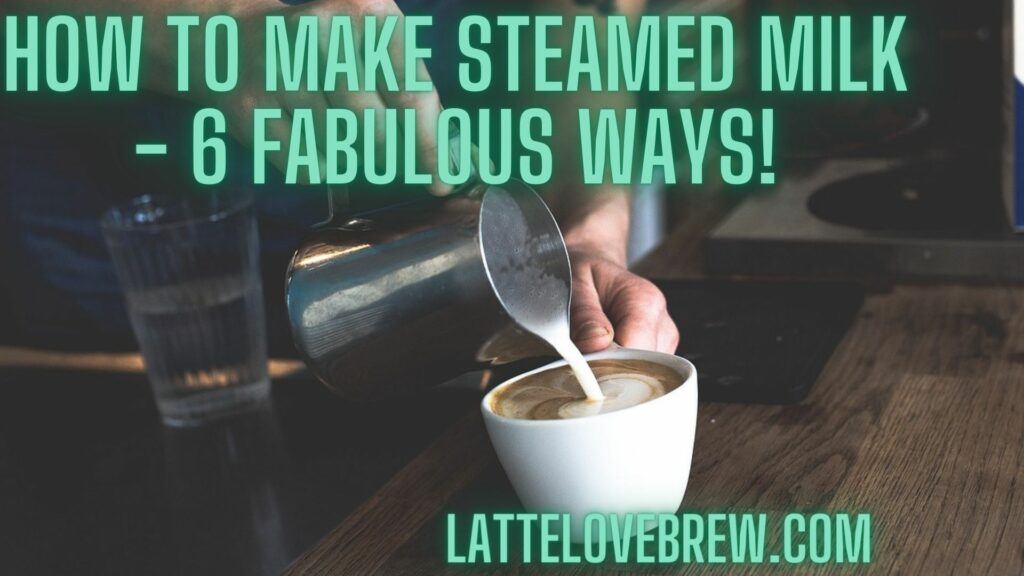Last updated on July 28th, 2024 at 14:29
If you want to know how to make steamed milk, this is the article for you as I not only give you six excellent ways in which you make steamed milk at home. I detail what kind of milk is best and why you need to be careful with plant based milks, and which brand of plant and nut based milks are best for steaming and frothing.
The best part?
Most of these methods don’t need any equipment, no steamer and can be used while you are on that weekend away or at the campsite!
Keep reading for the details!
How To Make Steamed Milk – What Is Steamed Milk?
Table Of Contents
Steamed milk is milk that has been produced by heating your milk using the steam wand attachment of your espresso machine. The process of heating injects a small jet of steam and air into your milk under pressure.
The process of exposing your milk to steam stretches and expands your milk, altering its structure and creating a silky, velvet-like texture. During the process, microbubbles are created giving the appearance of frothy milk.

Read: Boil milk for coffee
Steamed Milk Vs Frothed Milk – How Is Frothed Milk Different?
Foamed milk, also known as steamed milk, is the silky smooth milk foam that you see on many espresso based coffee beverages like a latte. It’s made by forcing air from your milk wand into your milk when you steam it. Foamed milk is popular with mochas and hot chocolate to give richer taste and texture. You can see it on lattes and flat whites too.
Frothed milk is dry and less watery when you compare it to steamed milk. It, frothed milk can hold its shape much better than the more liquid steamed milk which makes it better for latte art. It’s lighter and spreads quicker and easier due to the air bubbles instead of steam that is inside it.
What Kind Of Milk Is Best For Steaming?
Fresh whole fat cold milk is best. Traditionally, it is whole fat milk that is as the fat content matters a lot. As you steam you milk the fat expands and forms a protective layer that creates the microfoam. The greater the fat content and more of it the better your steamed milk will be.
Also, the fresher and colder your milk and your equipment like your milk jug are, the more stable and easier your milk will froth, foam and steam. Sure, many bars in warmer climates like Spain, all over Latin America, and Asia use UHT milk but that does not mean that it is the best milk to use.
Full-fat cow’s milk is preferred as the fat content has an effect on the texture and the flavor. This doesn’t mean that you can’t use skim milk or non-fat milk. The higher protein content helps to create bubbles that hold their air thanks to the fat content stretching and protecting them. The higher lactose content, the milk sugars give an additional sweetness.
Another benefit of whole milk is that it is creamier; because of this, it creates a richer flavor.
Plant-based milk like soy milk, almond milk and oat milk burns a lower temperature when compared to dairy milk. Coconut milk great due to the high fat content, making it very creamy and adding a tasty tropical flavor to your latte, cappuccino, mocha or flat white.
Alternative milk can be difficult to work with due to the problem of curdling. The Barista brand, a specialty company that focuses on making non-dairy milk for baristas. Their milks have an oat milk base or use gellan to make their easier to work with for steaming and frothing. I advise using this milk as it is much better and more convenient.

Read: What is steamed milk?
How To Steam Milk With A Steamer
Steaming milk is easy thanks to some very thoughtful modern steam wand designs. The process is much easier now than it was decades ago. All you need to do is to find the perfect angle.
Fill your milk pitcher to an inch below the start of the spout with cold milk. Allow plenty of room for the milk to expand. If you so wish and feel the need, you can use an espresso thermometer and attach it to the rim of your metallic milk jug. Personally, I find it much easier and more convenient to use a color-changing temperature tag and sticking it to the side of my milk jug.
Start by purging your stem wand, wiping and cleaning it before inserting it into your milk jug.
Insert your wand into your milk until it is only a touch below the surface, and tilt the jug at an angle and create a vortex, a whirlpool effect.
As your milk is spinning, insert your wand a little further. If you maintain your wand too close to the surface, you will end up inserting too much air into your milk. If you hear a kissing sound or tearing sound, tearing sound getting too loud or for too long it is a sign that your milk is getting too much air forced into it.
Once you have enough air into your milk and the temperature is 48C (120F), raise your pitcher to the starting position to stop more air from getting into your milk and hold it at that position and turn the milk foam into your milk until your milk reaches 60C (140F).
Stop when your milk reaches this temperature. It will continue to rise to 70C (158F), which is the perfect pouring temperature. While waiting tap the side of your milk jug a couple of times and bang it on the counter top. This banging is to free any trapped air.
Swirl your milk jug to shine your steamed milk. The end result should look like wet paint. Pour frothy milk into your latte, flat white or whatever beverage you are making, even hot chocolate.
How To Make Steamed Milk Without A Steamer
If you don’t have an espresso machine with a steam wand don’t worry as you can still make steamed milk without a steamer. The results are still good but just not as good you would get from a steam wand. Don’t expect coffee shop quality.
Using A Handheld Balloon Whisk
Start by heating your milk at a low to medium heat. As soon as you start to see steam rising from your milk it will be hot enough. Don’t let your milk boil. The golden rule is, if your boil, you spoil!
When your milk is warm enough, pour it into a large bowl and whisk with a balloon whisk, a basic handheld whisk and whisk with energy and vigor for 30 to 45 seconds. You’ll see your milk getting frothy, bubbly. When you have the desired consistency, get ready to transfer into your coffee beverage and pour it into the coffee. Hold back the layer of milk foam with a tablespoon and then scoop the milky foam onto the top of your drink.

Read: Steamed milk
Using A French Press Of Manual Hand Pump Milk Frother
If you don’t own a manual hand pump milk frother your French press can and will double up as an effective alternative for making well-foamed milk.
Start by heating your milk in a saucepan to a low to medium temperature until you start to see steam rising from your milk. At this point your milk is warm enough, at the perfect temperature.
Transfer your warm milk to your French press or hand pump milk frother. Fill to more than 1/3rd full. Close it and pump vigorously for 30 seconds to 45 seconds. Your milk will double in volume.
Pour your milk into your coffee while holding back the mound of milk foam with a tablespoon. Then scoop your milky foam on top of your beverage.
Use A Milk Frother
Start by gently heating your milk at a low to medium heat until you start to see steam rising from your milk. Take your milk off the heat and transfer to a tall glass.
Insert your milk frother and froth your milk starting at the bottom and slowly move it through your milk from bottom to top and back again until you get the consistency that you want and need. When you have well-foamed milk you can transfer to your coffee while holding back the milky foam with a tablespoon and then scoop the milk foam on your coffee drink.
Use A Mason Jar Or Cocktail Shaker
Start by warming your milk slowly using a low-medium heat. When you start to see steam and your milk getting to the simmering point, your milk is warm enough. Boiling your milk will spoil it.
When your milk is ready, pour it into your mason jar or cocktail shaker. Leave room for your milk to expand. Close your mason jar or cocktail shaker and shake with energy and vigor for 45 seconds to a minute and pour carefully into your coffee drink while holding back the milk foam before spooning it into your coffee.

How To Make Steamed Milk In Microwave
Steaming your milk in your microwave is quick and easy as most people have a microwave at home.
Start by pouring your milk into a microwave-safe jar and allow room for your milk to rise. Don’t fill more than the 1/3rd to half full mark. Shake your jar with vigor and energy for 45 seconds to a minute to make it frothy.
Put your jar with the frothy milk into your microwave and heat your milk in 10 second bursts until you start to see it expand and rise.
Carefully remove your jar and pour your hot milk into your coffee and spoon the layer of milk foam onto your coffee.
Frequently Asked Questions About How To Make Steamed Milk
Is Steamed Milk Just Warm Milk?
No, there is a structural difference between warm milk and steamed milk. The injection of a jet of steam at pressure that heats and steams your milk alters the fats and proteins structurally, giving it a different texture to milk that has been heated on the stove or in the microwave.
How Is Steamed Milk Made?
Steamed milk is made by introducing your milk to steam, a jet of pressurized steam from the steam wand of an espresso machine. The milk fats breakdown and expand, creating microbubbles. The greater the fat content, the better the quality and stability of the tiny air bubbles known as microfoam.
When made perfectly, you’ll have a silky velvet-like texture to your espresso drinks like a latte, cappuccino, cortado, flat white and more.
Can You Steam Milk Without A Frother?
Strictly speaking, no. You must have a steam wand to make steam milk. You can replicate the effect and make frothed milk using a different techniques like using an electric milk frother, a blender, a mason jar and even a French press or manual pump milk frother. Frothed milk is not the same as steamed milk.
How Hot Do Baristas Steam Milk?
The perfect temperature to steam milk is between 68C to 73C (155F to 165F). When you have experience and are adept at steaming milk, you won’t need to measure the temperature and will be able to do it by eye and feeling. A color-changing temperature control tag is a good too to stick to your milk jug.
Should Milk Be Cold Before Steaming?
Cold fresh milk will get the best results. However, based on my own extensive experience, hot countries like Spain and elsewhere in the world use UHT milk. There is no great deal of difference between fresh and UHT when steaming. Using a fresh batch each time is best. Heating and reheating will eventually reduce the quality of your steamed milk. Cold milk does produce the best quality microfoam.
What Milk Do You Use For Steamed Milk?
Traditionally, it is whole fat milk that is used to steam milk. At all gourmet coffee shops the type of milk that is used will be whole milk unless you specifically request something different like coconut milk, almond milk or fat-free milk.
You can use any milk with one caveat!
If you are using alternative milks, you absolutely must use the Barista brand as alternative milks are very hit-and-miss when frothing and steaming. Some are great, some brilliant but most are terrible. The low fat content and ratio of protein and fat make them curdle easy or unable to hold the air bubbles. Barista makes their milks specifically for frothing and steaming using oat milk base or gellan as a stabilizer.
Final Thoughts – How To Make Steamed Milk
Knowing how to make steamed milk perfectly and in different ways is good and gives you options when you can’t use your steam wand for whatever reason, it’s broken, you don’t have one, you are on a trip away.
Having choices is always good.
Join our fun and active coffee community! Pop in and say hi and feel free to post anything related to coffee be it recipes, your great creations or latte art, memes, jokes or coffee quiz! Find us on Facebook/Meta!







